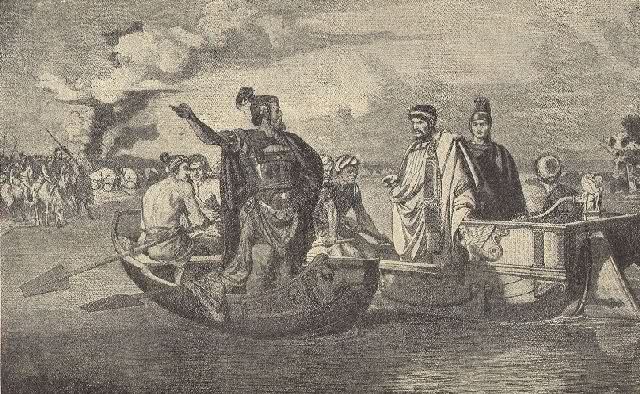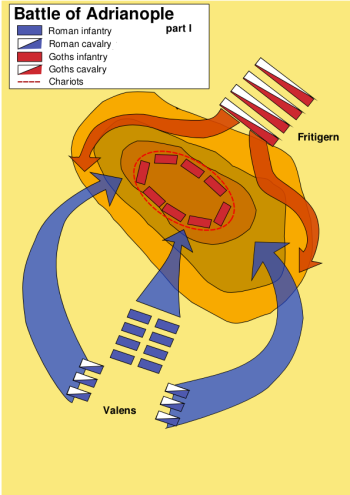| Apocalypse Then:
The Battle of Adrianople, Part Two
By David Meyler
September 2016
The Emperor Valens, on campaign against the Persians, patched up a quick peace and returned to the Balkans to deal with the situation in person. Richomeres (a Frank, yet another German in Roman service) in the meantime, led a composite army made up out of detachments from both the eastern and western halves of the Empire. An indecisive battle was fought in 377, with heavy losses on both sides, but the roving Gothic bands were generally forced to curtail the range of their activities.
By 378, the Emperor Valens was back in Constantinople with the eastern field army. At this news, Fritigern called back all the bands and formed a wagon-laager about 13 kilometres from Adrianople. A Roman reconnaissance put the main body of the Therungi at 10,000 fighting men (mostly foot). Even if this did not include Alatheus’s horsemen, the total could not have much exceeded 12,000 men.
The standard Roman field army at the time, allowing for some variance according to region or circumstance, was based on 1500 cavalry in three units, three legions (1200 heavy infantry each) and 3000 auxilia divided into six units (missiles troops and lighter infantry), for 8100 men. Really large concentrations of troops were usually not needed except against the Persian kings, who were the only opponents of the Romans that could raise and maintain equally massive field armies. With the addition of local militia and garrison troops, which were typically attached to a field army, Valens’ force was likely equal to, or may have even slightly outnumbered, Fritigern’s army.

Fritigern meets Valens mid-river.
Neither commander made an immediate attack, and negotiations began. It was a hot and dry summer day in August, and one or more of the Gothic camp fires resulted in a widespread grass fire, the smoke and flames adding to the dust, haze and heat of the day. In the end, Fritigern declared he would send hostages to Valens regardless of any internal opposition. It appears, then, that there were “hawk” and “dove” factions among Goths. However, the Therungi council approved Fritigern’s decision for peace, and Valens then agreed to an exchange of hostages. Richomeres with an escort of mounted archers was sent out to make the arrangements in the middle of the afternoon.
Then everything went wrong. We don’t know why – maybe Richomeres or one of his guard had some personal feud with one of the Goths, maybe there was an exchange of jeers or taunts – in any case, the Roman archers started firing on the Gothic laager. Just at this time, Alatheus and Saphrax arrived back at camp. Seeing their allies under an apparent attack, the Greuthungi horsemen charged. Caught by surprise, the mounted archers fled, but the infantry formed a line.
A general battle now erupted (as shown in Scenario 10, in Fading Legions) as the Therungi infantry charged out of the laager to come to the aid of Alatheus. The surprise, dust, smoke and haze led to a very confused battle. Neither Fritigern nor Valens could offer much in the way of command control. Many of the Goths still went to battle with little or no armour, and wielding only wooden clubs. The legionaries, although maybe showing less initiative than the more fluid German warbands, were generally veteran soldiers, well armed and armoured, and as long as they maintained their cohesion they would be impossible to move.
 The Roman left wing cavalry charged and reached the wagon-laager, but the Roman infantry remained pinned, and the right wing cavalry was routed. Without support, the Roman left then crumbled. Each German band fought its own battle, and although now pressed on both flanks and suffering losses, the line of heavy Roman infantry held. The Roman left wing cavalry charged and reached the wagon-laager, but the Roman infantry remained pinned, and the right wing cavalry was routed. Without support, the Roman left then crumbled. Each German band fought its own battle, and although now pressed on both flanks and suffering losses, the line of heavy Roman infantry held.
In the end, it was darkness that ended the fighting with parts of the Roman line still intact. However, disaster had struck. Valens had been wounded in the battle, and could not be found in the darkness. The Roman army broke apart, with most fleeing back towards Adrianople. Valens’ body was never found. Ammianus says the Romans lost about two-thirds of the army – about 8000 men – but as there was no pursuit, some of those scattered during the night likely found their way back to the ranks. Considering the lack of body armour among the Goths, losses among the Germans were probably on par with those of the Romans.
Map by Arnaud Gaillard.
Overall, Adrianople was a nasty and confused battle of moderate size and length – five to six hours (from about 3 to 8 pm). One could have even added inconclusive, but for the fact that Valens was killed. The unexpected loss of an emperor had always been dangerous for the Romans, but was by no means fatal. In 378 and the following year, things indeed might have looked black if you were a Roman. And if you were a pagan Roman, you could see Adrianople as just punishment (incidentally, both Valens and Fritigern were Arian Christians).
Ammianus compared the battle to Cannae, 216 BC, where an estimated 50,000 Romans were killed by Hannibal’s army. Looked at from a wider perspective, this was clearly an exaggeration, as the Romans had suffered a number of catastrophic defeats in their long history. To list a few:
Arausio, 105 BC where 40,000-plus Romans were killed by the Teutones and Cimbri (leading to the Marian civil wars)
● Arausio, 105 BC where 40,000 plus Romans were killed by the Teutones and Cimbri (leading to the Marian civil wars).
● Carrhae 53 BC, Crassus killed, 20,000 dead and 10,000 prisoners, and seven legionary eagles lost to the Parthians, directly leading to the show down between Pompey and Caesar.
● Teutoburger Wald 9 BC, 20,000 men and three legionary eagles lost, casting a long shadow on the golden age of Augustus’ reign.
● Year of the Four Emperors 69 AD, the first major civil war of the empire, it established a dangerous model when the succession of a new emperor was in doubt.
● Capture of Valerian by Shah Shapur I during the Persian Wars 260 AD, leading to one of the worst Roman civil wars (stability was not re-established until Diocletian came to power in 284).
The Romans rallied in the city of Adrianople after the battle, and the Goths were unable to storm its walls. An attempt was then made to storm Constantinople, but this also failed with heavy losses among the Goths. They had no skill, means or patience to maintain a siege, and Fritigern’s men then dispersed. Afterwards, the Gothic bands took up their plundering raids again in the southern Balkans, but were unable to capture any major Roman garrison.
By 381, the new Emperor Theodosius had made a peace, settled the Goths into the empire as originally planned, and added their fighting men to the strength of the Roman armies, thus largely negating the losses resulting from the defeat at Adrianople. The Goths did good service in the ongoing wars against Persia, and in putting down two revolts against Theodosius in the west.
While Adrianople was serious, it was considerably smaller than any of the battles mentioned above, and its worst effects were dealt with in less than three years. The loss in manpower was readily made up, the Goths under Fritigern never amounted to more than a regional threat, and potentially the most serious loss, that of the emperor, did not result in civil war.
The Haunting
Did I mention haunting? One other consequence of the battle has a more occult aspect. During the fighting in front of Constantinople after the battle, Ammianus reports this incident:
“A body of Saracens [Roman allied light cavalry]… being more suited for sallies and skirmishes than for pitched battles, had been lately introduced into the city; and, as soon as they saw the barbarian host, they sallied out boldly from the city to attack it. There was a stubborn fight for some time; and at last both armies parted on equal terms.
But a strange and unprecedented incident gave the final advantage to the eastern warriors; for one of them with long hair, naked – with the exception of a covering round his waist – shouting a hoarse and melancholy cry, drew his dagger and plunged into the middle of the Gothic host, and after he had slain an enemy, put his lips to his throat, and sucked his blood. The barbarians were terrified at this marvellous prodigy, and from that time forth, when they proceeded on any enterprise, displayed none of their former and usual ferocity, but advanced with hesitating steps.”
A vampire attack in the Balkans: is this how the undead arrived in their beloved Transylvania? Except for Fritigern’s revolt would there never have been a Dracula legend, no Bram Stoker novel, no Nosferatu, no Bela Lugosi or Christopher Lee, no Twilight franchise? Maybe that’s the biggest consequence of the battle of Adrianople.
A bloodsucker variant for the Adrianople scenario in Fading Legions: Although there is no report of vampirism at Adrianople, here is a suggestion: After at least six turns (you have to wait for sunset), the Roman player can shout “vampire!” before making an assault. The area morale of the defender is considered to be a 1for that pre-assault morale check only. The Gothic player gains 2 VP since you have unwittingly unleashed the scourge of the undead.
Bibliography
Ammianus Marcellinus. The Later Roman Empire, Penguin Books, Great Britain, 1986.
Barker, Philip. The Armies and Enemies of Imperial Rome, Wargame Research Group, Great Britain, 1972.
Bury, J.B. The Invasion of Europe by the Barbarians, Russel and Russel, New York, 1963.
Gibbon, Edward. Gibbon’s Decline and Fall of the Roman Empire, J.M. Dent and Sons, London, 1960.
Jordanes. The Gothic History, Speculum Historiale, Cambridge, 1966.
Thompson, E. A. The Early Germans, The Clarendon Press, Oxford, 1965.
The story began in Part One
Order Fading Legions today and play out the battle on your gaming table.
|
